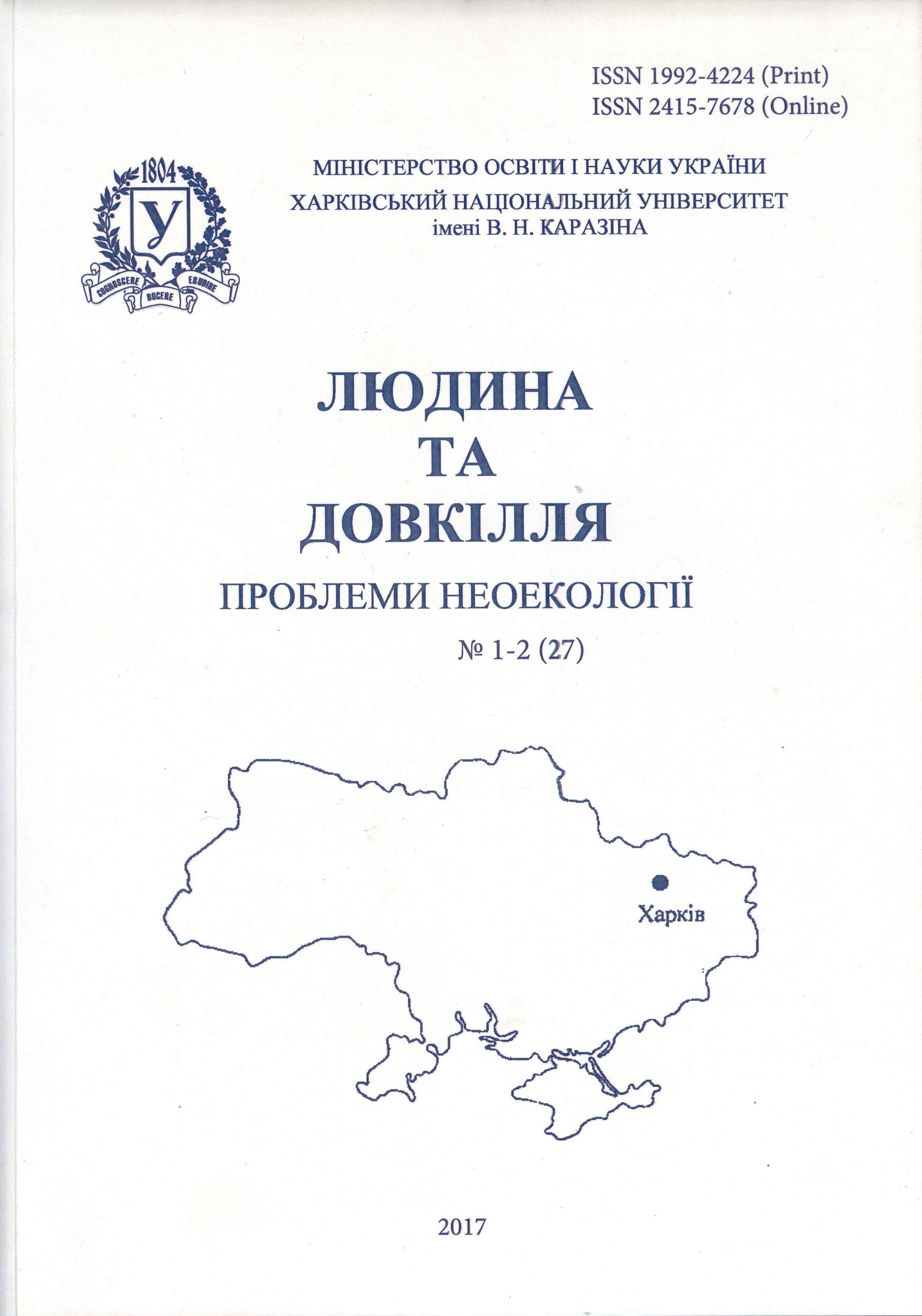Оцінка екологічної стійкості ландшафтів річок басейну Західного Бугу у Волинській області
Анотація
Мета. Визначення екологічної стійкості ландшафтів басейну річки Західний Буг та її приток на Волині для оцінки екологічної ситуації басейну р. Західний Буг. Методи. Порівняльно-географічний, аналітичний, узагальнення, систематизації, обрахунки екологічної стійкості ландшафту на основі методики Е. Клементової, В. Гейниге. Результати. Встановлено, що у ландшафтах басейну річки Західний Буг Волинської області переважає екологічно середньо збалансована їх структура при показнику КЕСЛ1 1,04. Це зумовлено структурою земель басейну, де значну частину займає площа дестабілізуючих ландшафтів із сільськогосподарським навантаженням (рілля). Найбільші площі ріллі зайняті у суббасейнах рр. Студянка і Луга, а найменші – у суббасейнах рр. Неретва, Золотуха, Гапа, що пов’язано із значною залісненістю території басейну. Якісна оцінка екологічної стійкості ландшафту характеризується коефіцієнтом екологічної стабільності біотехнічних елементів всього ландшафту КЕСЛ2. Розрахунки kЕСЛ2 показали, що структура ландшафтів басейну річки Західний Буг у Волинській області є мало стабільною і показник становить 0,48. Коефіцієнти kЕСЛ2 басейнів річок Студянка та Луга сягають відповідно 0,21 та 0,23 і характеризують їх як нестабільні геосистеми. Структура ландшафтів басейнів річок Піщатка та Копаївка за kЕСЛ2 - (0,95 – 0,67) належить до стабільних. Отже, інтенсивне освоєння земель, осушення боліт, вирубування лісів порушили цілісність ландшафтів, зумовили їх денатуралізацію. Особливо значних змін зазнала південна частина басейну. Висновки. В результаті проведених обрахунків кількісної оцінки екологічної стабільності ландшафтів (kЕСЛ1) ландшафти басейну річки Західний Буг у Волинській області є умовно стабільними. А за показниками якісної оцінки екологічної стійкості ландшафту (kЕСЛ2) вони характеризуються як малостабільні геосистеми. Загалом визначення стійкості ландшафту має важливе значення для оцінки екологічної ситуації басейну р. Західний Буг, оскільки у повній мірі відображає загальний екологічний стан річкового басейну.
Завантаження
Посилання
Armand, A. D. (1983). Ustojchivost' geograficheskih sistem k razlichnym tipam vneshnih vozdejstvij. [Stability of geographic systems to various types of external influences]. The stability of geosystems. M.: Science, 14-32. [in Russian].
Bokov, V. A., Bobra, T. V., Lychak, A. Y. (1998). Normirovanie antropogennoj nagruzki na okruzhayushchuyu prirodnuyu sredu [Normalization of anthropogenic pressure on the surrounding natural environment]. Symferopol : TЭY, 110. [in Russian].
Boiaryn, M. V. (2010). Konstruktyvno-heohrafichni osnovy pryrodokorystuvannia v baseini richky Zakhidnyi Buh.[ Structural and geographical basis of nature management in the basin of the Western Bug River]. Nauk. visn. Volyn. nats. un-tu im. Lesi Ukrainky. Lutsk, 15 : Heohrafichni nauky. 166–170. [in Ukrainian].
Boiaryn, M. V., Netrobchuk, I. M. (2012). Otsinka ekolohichnoi stiikosti landshaftu baseinu richky Zakhidnyi Buh u mezhakh Volynskoi oblasti. [Estimation of ecological stability of the landscape of the basin of the Western Bug River within the Volyn region.] Ukraina: heohrafiia tsilei ta mozhlyvostei. Zbirnyk naukovykh prats. – K. : VHL «Obrii», I,. 29-33. [in Ukrainian].
Glazovskaya, M. A. (1983). Principy klassifikacii prirodnyh geosistem po ustojchivosti i tekhnogenezu i prognoznoe landshaftno-geohimicheskoe rajonirovanie.[ Principles of classification of natural geosystems for stability and technogenesis and predictive landscape-geochemical zoning]. The stability of geosystems. M.: Science, 61-77.
Hrodzynskyi, M. D. (1995). Stiikist heosystem do antropohennykh navantazhen.[ Stability of geosystems to anthropogenic loads]. K. : Likei, 233. [in Ukrainian].
Hutsuliak, V. M. Landshaftoznavstvo : teoriia i praktyka. Chernivtsi : Ruta, 2005. 124 . [in Ukrainian].
Zvonkova, T. V. (1987). Heohrafycheskoe prohnozyrovanye: ucheb. posob. dlia heohr. spets. Vuzov. [Geo-graphic Forecasting: Textbook. Help. for geogr. Specialist High schools]. M.: High School,. 192 . [in Russian].
Ysachenko, A. H. (1991). Landshaftovedenye y fyzyko-heohrafycheskoe raionyrovanye.[ Landscape sci-ence and physicogeographical zoning]. M.: Science, 47-60. [in Russian].
Klimenko, N. A., Liho, E. A., Voznyuk, N. N.,Statnik, I. I., Efimchuk, E. B. (2005). Rajonirovanie bassejna reki Zapadnyj Bug v zavisimosti ot antropogennoj nagruzki [The zoning of the Western Bug River basin de-pending on anthropogenic load ]. Proceedings of the VII International Conference. Warsaw, 201–206. [in Russian].
Klementova, E., Gejnige, V. (1995). Ocenka ehkologicheskoj ustojchivosti sel'skohozyajstvennogo landshafta.// Melioraciya i vodnoe hozyajstvo, [Evaluation of the ecological stability of the agricultural landscape]. Melioration and water management, 5, 24-35. [in Ukrainian].
Myskovets, I. Ya. )2003). Antropohenni zminy v baseinakh malykh richok ( na prykladi Volynskoi oblasti) [Anthropogenic changes in the basins of small rivers (on the example of the Volyn region)]: Chernivtsi: 19. [in Russian].
Netrobchuk, I. (2012). Otsinka antropohennoho navantazhennia ta ekolohichnoi zbalansovanosti landshaftiv richkovoi dolyny verkhnoi Prypiati v mezhakh Volynskoi oblasti. [Evaluation of anthropogenic load and ecological balance of the landscapes of the river-valley of the upper Pripyat within the Volyn region]. Nauk. visn. Cherniv. un-tu. 612-613 : Heohrafiia.133-137. [in Ukrainian].
Puzachenko, YU. G.(1983). Invariantnost' geosistem i ih komponentov. The stability of geosystems. M.: Science, 32-41. [in Russian].
Fesiuk, V. O. (2016). Suchasnyi ekolohichnyi stan ta perspektyvy ekolohichno bezpechnoho stiikoho rozvytku Volynskoi oblasti. [The current ecological status and prospects of environmentally safe sustainable development of the Volyn region] K. : TOV «Pidpryiemstvo VI EN EI» , 316. [in Ukrainian].
Автори, які публікуються у цьому журналі, погоджуються з наступними умовами:
- Автори залишають за собою право на авторство своєї роботи та передають журналу право першої публікації цієї роботи на умовах ліцензії Creative Commons Attribution License 4.0 International (CC BY 4.0), котра дозволяє іншим особам вільно розповсюджувати опубліковану роботу з обов'язковим посиланням на авторів оригінальної роботи та першу публікацію роботи у цьому журналі.
- Автори мають право укладати самостійні додаткові угоди щодо неексклюзивного розповсюдження роботи у тому вигляді, в якому вона була опублікована цим журналом (наприклад, розміщувати роботу в електронному сховищі установи або публікувати у складі монографії), за умови збереження посилання на першу публікацію роботи у цьому журналі.
- Політика журналу дозволяє і заохочує розміщення авторами в мережі Інтернет (наприклад, у сховищах установ або на особистих веб-сайтах) рукопису роботи, як до подання цього рукопису до редакції, так і під час його редакційного опрацювання, оскільки це сприяє виникненню продуктивної наукової дискусії та позитивно позначається на оперативності та динаміці цитування опублікованої роботи (див. The Effect of Open Access).





